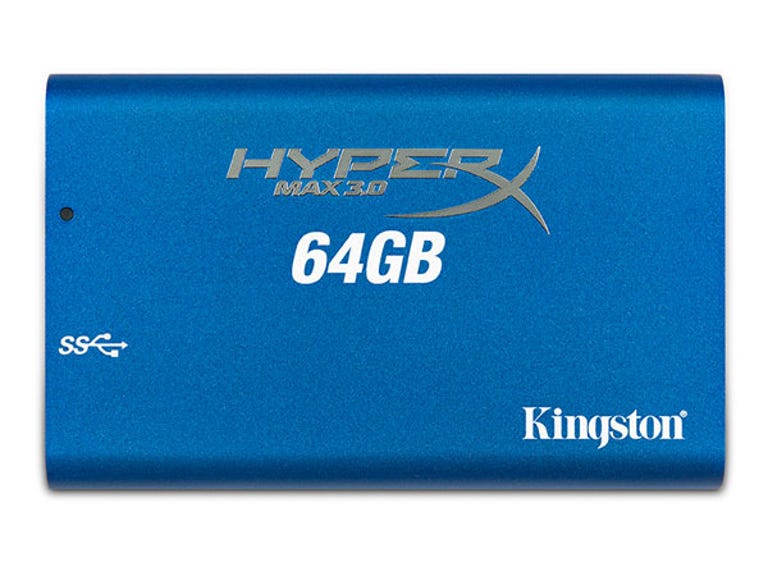 Why You Can Trust CNET
Why You Can Trust CNET Kingston HyperX Max 3.0 (64GB) review: Kingston HyperX Max 3.0
So you feel the need for speed? Kingston's HyperX Max 3.0 USB will deliver it, but you'll pay a premium for all that velocity.
Design
When we first clapped eyes on the Kingston HyperX Max 3.0, we mistook it for a business card holder. We've certainly seen sillier things adorned with company logos, but this is no mere device for storing professional details in an archaic way. Measuring in at 73.49x118.6x12mm, it's quite small and will easily slip into a pocket or bag. There's a single activity indicator light and a micro B male-type USB socket at the back of the drive. It feels solid in the hand and well-built, unlike many external drives that sport a distinctly cheap plastic feel. Then again, at the price point the Kingston HyperX Max 3.0 commands, "cheap" isn't a word that'll be used around it all that much. Aside from the drive, the only other accessory included with the Kingston HyperX Max 3.0 is a standard USB 3.0 micro B to A-type cable for connecting the drive to a compatible PC.
The Good
The Bad
The Bottom Line
Features
Underneath the funky aluminium casing of the Kingston HyperX Max 3.0 lies an SSD (solid-state drive; if that's got you scratching your head, this article should clear things up: Five reasons SSDs are great). The Kingston HyperX Max 3.0 is sold in three sizes: 64GB (AU$249), 128GB (AU$389) and 256GB (AU$819). We were supplied with the entry-level 64GB model for testing. The 3.0 in its name betrays its other key selling point: it's USB 3.0 compatible, and will even let you know if it's plugged into a USB 3.0 port or a USB 2.0 port by the colour in which the drive lights up. If it's lit up in blue, you're connected at full USB 3.0 speed; if it's green, you're toddling along with USB 2.0.
Kingston's product page for the HyperX Max 3.0 states that it offers read speeds of up to 195MBps and write speeds of up to 160MBps. Naturally enough, that's with USB 3.0; don't expect these kinds of speeds if you're plugging it into a USB 2.0 port. The short USB 3.0 cable is a minor annoyance, as most of the systems (including our test rig) with USB 3.0 will be desktops with an additional USB 3.0 card at the rear of the drive rather than front-mounted ports, making the drive itself a little tricky to plug in.
One thing you won't get with the Kingston HyperX Max 3.0 is any additional software for backup duties. Some folks will see this as a blessing, but we'd rather have it, and format it away, than be left without — especially at this price point.
Performance
In order to get the most out of the HyperX Max 3.0, you'll need a system with USB 3.0 capabilities, either by adding a card to a desktop machine or by utilising one of the relatively few notebook systems that come with USB 3.0 pre-installed. For the purposes of this review, we used a Gigabyte GA-USB 3.0 card, which was supplied to us by Kingston for testing the HyperX Max 3.0 drive.
First testing of the read speed with synthetic benchmark HDTach revealed an average read speed of 109.4MBps. That's well below Kingston's stated 195MBps rate, but it's qualified with the magical "up to" statement. In any case, that's quite quick, at least at a synthetic level.
Switching over to real-world file transfers revealed a slightly different story. It's worth noting that our transfers were from an internal mechanical hard drive; if you really wanted to maximise the speed potential of the Kingston HyperX Max 3.0, a system that also featured an internal SSD could give you superior performance. Then again, this is a portable external drive and it's quite feasible that owners of it will be plugging it into systems that aren't equipped that way.
Transferring a 624MB file to and from the Kingston HyperX Max 3.0 took an average of 10.54s and 9.67s respectively, giving us an average read/write speed of 59.2MBps and 64.5MBps — figures that fall well below the manufacturer's figures. It's disappointing, but that's more to do with Kingston's hype than with anything else. To give those figures some context, we grabbed another flash-based storage device that happened to be sitting nearby: a USB 2.0 4GB Sony USM4GN Micro Vault Classic. A much cheaper drive, to be sure, but we plugged it in and ran the same file transfer tests. The Classic managed the same file transfer in a significantly more leisurely 136.51 seconds for an average 4.57MBps write rate and 34.49s for an average 18.09MBps read rate. In other words, while the Kingston HyperX Max 3.0 may not live up to its own hype, it certainly blows anything USB 2.0-based out of contention — as it certainly should.
Conclusion
The Kingston HyperX Max 3.0 is a very fast drive under the right circumstances, and if all you need is raw speed in your external storage it's an excellent option. SSD prices have tumbled in recent years, but they haven't collapsed in the way that, for instance, standard USB flash drives have. The same AU$249 that the Kingston HyperX Max 3.0 will cost you could buy more than 2TB of external mechanical drive storage with enough change left over for overflowing pocketfuls of USB 2.0 flash drives, but neither of those options would be anywhere near as quick.


